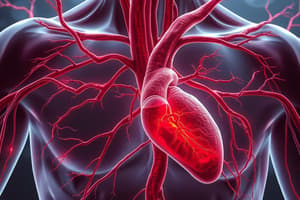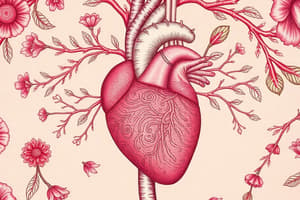Podcast
Questions and Answers
What is the primary force that opposes fluid movement out of the capillaries?
What is the primary force that opposes fluid movement out of the capillaries?
- Osmotic pressure (correct)
- Hydrostatic pressure
- Blood pressure
- Interstitial fluid pressure
Where is the fluid pressure generally the greatest in the capillaries?
Where is the fluid pressure generally the greatest in the capillaries?
- At the midpoint of the capillaries
- Throughout the entire length of the capillaries
- At the venous end of the capillaries
- At the arterial end of the capillaries (correct)
What is the approximate volume of fluid lost from capillaries daily?
What is the approximate volume of fluid lost from capillaries daily?
- 2-4 L
- 8-10 L
- 4-8 L (correct)
- 1-2 L
What is the term for the fluid that returns to the blood via the lymphatic system?
What is the term for the fluid that returns to the blood via the lymphatic system?
Where does the lymphatic system drain into the cardiovascular system?
Where does the lymphatic system drain into the cardiovascular system?
What is the primary mechanism that assists the movement of lymph from peripheral tissues to the heart?
What is the primary mechanism that assists the movement of lymph from peripheral tissues to the heart?
What is the primary mechanism by which blood flow is regulated in sapillary beds?
What is the primary mechanism by which blood flow is regulated in sapillary beds?
What is the primary route of transport for small solutes such as sugar, salts, and sea across the capillary wall?
What is the primary route of transport for small solutes such as sugar, salts, and sea across the capillary wall?
What is the role of blood pressure in the movement of fluid between the capillaries and surrounding tissues?
What is the role of blood pressure in the movement of fluid between the capillaries and surrounding tissues?
What is the function of the microscopic pores in the capillary wall?
What is the function of the microscopic pores in the capillary wall?
What is the primary reason why blood cells and proteins remain in the capillaries?
What is the primary reason why blood cells and proteins remain in the capillaries?
What is the net result of the opposing forces of blood pressure and osmotic pressure on the movement of fluid between the capillaries and surrounding tissues?
What is the net result of the opposing forces of blood pressure and osmotic pressure on the movement of fluid between the capillaries and surrounding tissues?
Flashcards are hidden until you start studying
Study Notes
Blood Pressure and Fluid Movement
- Fluid movement out of capillaries is opposed by the difference in osmotic pressure between the blood and interstitial fluid.
- On average, blood pressure is greater than the opposing forces, leading to a net loss of fluid from capillaries.
- This loss is greatest at the arterial end of capillaries, where blood pressure is highest.
Fluid Return by the Lymphatic System
- The adult human body loses approximately 4-8 L of fluid from capillaries to surrounding tissues daily.
- The lymphatic system returns lost fluid and proteins to the blood through a network of tiny vessels intertwined with capillaries and larger vessels.
- The composition of lymph is similar to that of interstitial fluid.
- The lymphatic system drains into the veins of the cardiovascular system at the base of the neck.
Blood Flow Regulation
- Blood flow to specific areas is regulated by the constriction and dilation of arterioles that supply capillary beds.
- Opening and closing of these vessels redirect blood flow to particular sets of capillaries.
- For example, blood flow to the skin is increased to help with heat loss, and blood flow to the digestive tract increases after meals.
Capillary Exchange
- The critical exchange of substances between the blood and tissues occurs across the thin endothelial walls of capillaries.
- Some substances are carried across the endothelium in vesicles, while others (like O2 and CO2) diffuse through endothelial cells or through microscopic pores in the capillary wall.
- Small solutes (e.g., sugar, salts, and water) are transported through the capillary wall, driven by blood pressure.
- Two opposing forces control the movement of fluid between capillaries and surrounding tissues: blood pressure tends to drive fluid out, while osmotic pressure of blood proteins tends to pull fluid back.
Studying That Suits You
Use AI to generate personalized quizzes and flashcards to suit your learning preferences.




